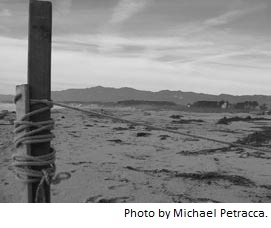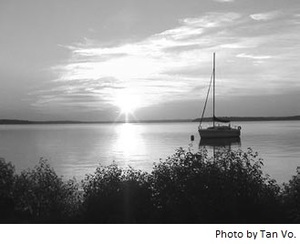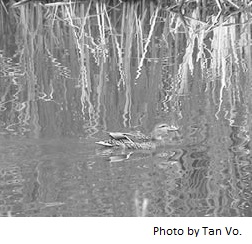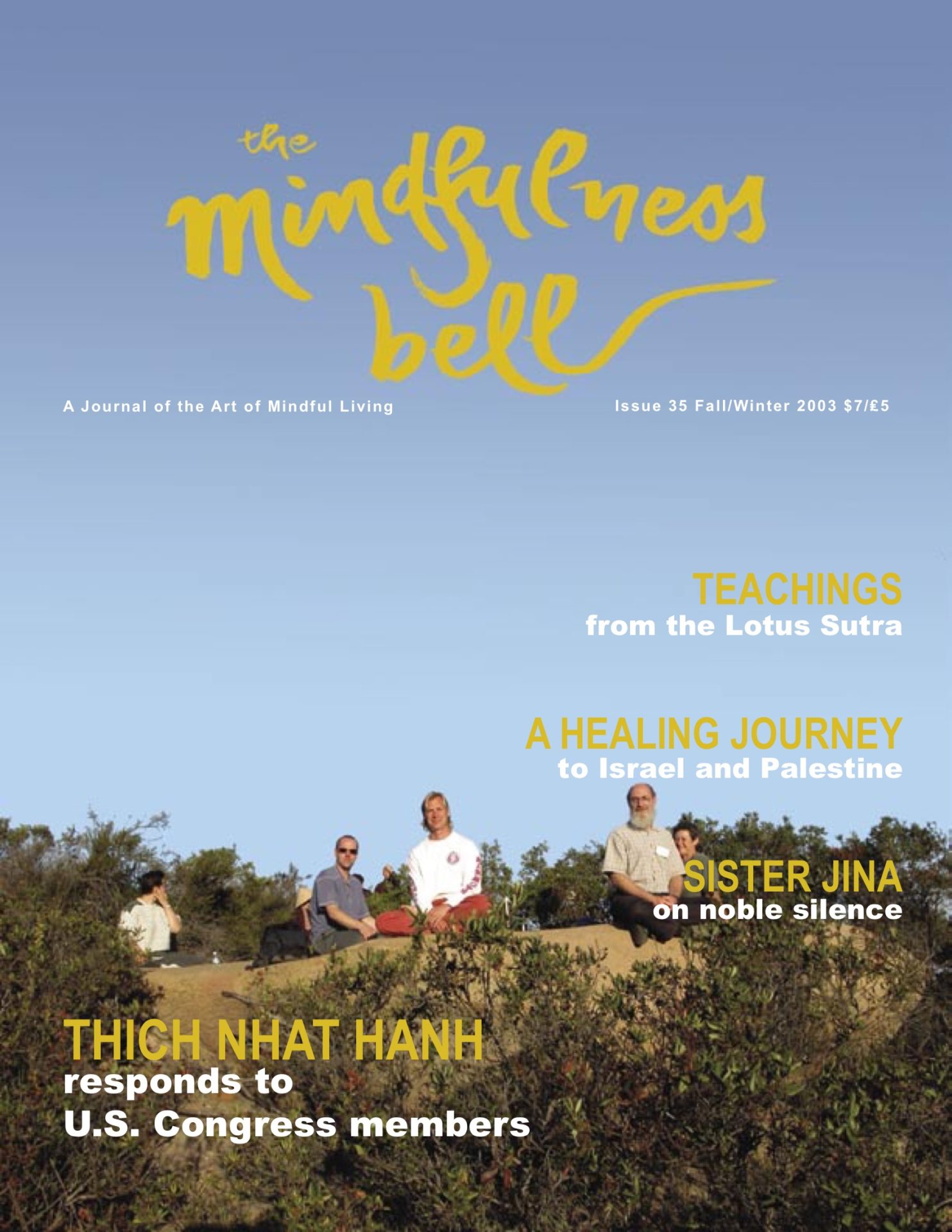
By Michael Petracca
I unlock the plover shed, a cinder block storeroom atop a cliff overlooking the Pacific. Through the shed’s salt filmy window, the sea looks glassy under a thick batting of overcast. Rust-colored kelp undulates slowly at low tide. Pelicans glide parallel to shore, pull up abruptly, plunge, splash. No surf to speak of today. The shoreline appears empty, save two black turkey buzzards pecking at a dead thing far up the beach.

By Michael Petracca
I unlock the plover shed, a cinder block storeroom atop a cliff overlooking the Pacific. Through the shed’s salt filmy window, the sea looks glassy under a thick batting of overcast. Rust-colored kelp undulates slowly at low tide. Pelicans glide parallel to shore, pull up abruptly, plunge, splash. No surf to speak of today. The shoreline appears empty, save two black turkey buzzards pecking at a dead thing far up the beach.
over the kelp beds
ragged line of pelicans
like smoke in still air
The faded, once-blue canvas daypack is heavy. It holds: birding binoculars; brown data clipboard and research data entry sheets; spare dog leashes; cell phone; economy tube of sunscreen; several ocean-rounded rocks for scaring crows, who enjoy plucking eggs from plover nests like bonbons from a box; docent procedure manual in white three-ring binder; stack of Coal Oil Point Reserve flyers.
The flyers explain that the Snowy Plover Docent Program started in 2001, to help save the plovers from extinction, and “to raise awareness in the local community of the importance of the preservation of this species and its habitat.” They say that the Reserve is the only area where plover breeding has been recovered through management efforts and a strong volunteer docent program. I heft the pack over one shoulder, pick up the sighting scope and its tripod, and make my way down the crumbling shale bluff that overlooks Coal Oil Point Reserve.
foggy fall dunescape:
seaweed, sodden driftwood,
tern tracks in wet sand
Heading west, down the dunes and toward the roped-off Reserve. Workboots sink deep, thighs burn, breath comes deep and slow. Suddenly, a trick of the eye. The sandscape appears to move, as though the beach ahead were its own small geologic plate in earthquake time. A whole sheet of sand shifting away from me. It can’t be the wind; there is none. I look again. Snowies! What appeared at first glance as empty beach is actually a flock of our puffball charges, each hunkered down in a human heel print, perfectly hidden from view. My approach caused the flock to move en masse, from one heel print to the next, and as I approach slowly so as not to scare the birds into flight, the flock gradually moves from heel print to heel print, finally taking up temporary residence on the other side of the ropes, inside the Reserve perimeter.
cold autumn windstorm—
each small shorebird takes refuge
in a heel print hole
Plovers don’t know that they’re on a list of creatures whose existence on this planet hangs by a fraying thread. They don’t know that we docents are on the beach to protect them, or that the ropes mark a safe zone for them. Consequently, they rarely thank us (although their peet-peet cries, as they veer and wheel overhead, come as a blessing), and they pay no heed to the ropes.
In fact, plovers will occupy any territory that seems friendly at the moment. For short-term shelter, plovers will sometimes choose the bunker-like protection of uneven terrain over the more exposed flat of the Reserve. But if there were no roped area, there would be no plovers ... or a lot fewer of them. For more than a decade before the Docent Program was implemented, breeding had completely stopped here, due to foot traffic—mainly students and their dogs—and the encroachment of non-native ground cover, which reduced the amount of camouflage-protective sand. Last year, after habitat restoration and the implementation of the docent program, we had fourteen nests, and nine plover chicks hatched and fledged.
blue sky, cirrus cloud,
small crew of westering gulls,
warm sun on dark cloth
The fog is burning off, and the foghorn has ceased its reedy moan. Reaching the eastern boundary of the Reserve, I open the tripod, set up the scope, and sight through it. At 32X magnification the far end of the Reserve looks like the moon’s surface. Hummocky terrain littered with small boulders. I pan the scope until some shorebirds come into sight. At first, a few non-endangered whimbrels and gulls loitering ... then, finally, a small assembly of plovers, some motionless on sand, others darting quickly, pecking, and beach-running. I fix the scope on a still one, turn the fine-focus wheel until the plover comes into clarity. Around five inches long, stocky, whitish-tannish upper body and darker patches on the upper breast, short black legs. Eyes closed, dreaming of ... what? Plover mind: Zen-empty?

I look around, take a deep, slow breath. Happy to be here, cleansed momentarily of thought. Plover mind. The air at Coal Oil Point smells like the air nowhere else. Salt mixes with a pungent smell of tar, due to natural offshore seepage that lends Coal Oil Point its name.
one seagull feather—
sandy, matted with dried tar,
tangled in seagrass
In the very old days, the Chumash used to make good use of the seepage. They used tar to caulk their thirty-foot redwood tomols, which they paddled up and down the coast and out to the Channel Islands for fish, abalone, and pleasure cruises. They wove grasses into twine bottles and coated them on the inside with beach tar to make them watertight.
More recently the oil companies arrived to tap the offshore petroleum reservoirs. Oil gets produced at the 7,500 ton Platform Holly, two miles offshore but very visible from the beach: by day, a stumpy, stilted erector-set box that intrudes on the gentle arc of the horizon; by night, an Orc-castle of twinkling lights and occasional gas-jet flares. At another site a mile east of the platform, natural methane is caught by two “seep tents,” massive steel pyramids installed by ARCO a couple of decades ago. A three-mile-long plexus of pipes and buoys connects Platform Holly and its neighboring seep tents with the Ellwood Oil & Gas Processing Facility just up the coast. Harbor seals have taken up permanent residence on every single buoy, and when wind is blowing just right, Coal Oil Point Reserve sounds like an overcrowded kennel at feeding time.
broken pismo shell
half-covered with
sand, seagrass,
crawling with sand flies
Coal tar is everywhere at Coal Oil Point, and if you walk the beach for fifteen minutes your feet will be covered. I take a seat on the fold-out nylon/aluminum chair and as I start entering data on the record sheet, a sixty-something human beach-runner with beat-up straw hat, cut-off jeans and sturdy calves rounds Devereux Point. He heads up the beach, sees me and stops to look through the scope. “Nice birds,” he says when the plovers come into focus. He looks up. “But what’s the point? I mean, if it’s their time to go, then why fight it? That’s evolution.”
His voice carries no tone of challenge. He really wants to know.
Reasonable question. No one would dispute that human presence has a devastating impact on the world and its passengers. However, species were dying off long before we arrived on the scene. Volcanoes belched sulfurous fog, ice blanketed the continents, hurricanes raged, oceans rose, lakes dried, colliding asteroids ushered in eons of sunless cold ... all with attendant extinctions. A millennial winter here, a grossly overpopulating and morbidly polluting human species here and now: all engines of evolution. Natural selection is nothing if not natural. If plovers are destined to go the way of the pterodactyl, why fight it?
unpeopled sand dunes
right out of prehistory—
jet fighter rises
For replies to the beach-runner’s question, you can dab at a broad palette of viewpoints. The utilitarian: plovers don’t provide fuel oil or good eatin’—no big loss if we lose some insignificant white puffballs. The ecological: nature exists in a delicate balance, and losing seemingly insignificant species may have dire effects that we can’t foresee. The eco-philosophical: all non-human and human life have inherent value, and we humans—as stewards of the planet—have a responsibility to protect this richness and diversity. The deep-deep ecological: keep the plovers, lose the people. The fatalist: our humble nearby star, the sun, will go red giant in a few billion years, rendering this whole planetary experiment moot ... so why bother saving anything? The words of my beloved: save the plovers because they’re cute!
white heron standing
stockstill in wind-ruffed salt marsh
dips its head sharply
What I tell the beach-runner comes from docent training: “Plovers have been here much longer than people. They stopped breeding because of people and their dogs, and coastal development. I just want to give them a chance to come back.”
“Well, I’m glad somebody’s doing this,” the beach-runner says.
“Me, too!” I’m cheerful. The Plover Manual also recommends that docents “make an effort to be helpful and friendly at all times.” Sound advice, and not just on a bird reserve.
“Have a good one,” the beach-runner calls over his shoulder as he resumes jogging.
On my own again, I take out the Norton Haiku Anthology I often bring to my plover shift to read after I finish my research duties. Like breathing meditation or Vietnamese kinh hanh (slow-walking meditation) practice, haiku puts me in a state of mind in which the senses are fully awake, the mind engaged in the instant. Today I read Issa, the eighteenth century Japanese hermit-wanderer.

The toad! It looks like
it could belch
a cloud.
That wren—
looking here, looking there.
You lose something?
What good luck!
Bitten by
This year’s mosquitoes, too.
I close the book and walk down the beach, along the length of the plover exclosure. Reading haiku on the beach sometimes has the effect of turning the mind into a random verse generator. It primes the literary pump, seventeen-syllable shortforms springing to mind and page unbidden and fully formed. Today words come:
sodden redwood burl
smooth and dark-stained by ocean
looks like a cow skull
green fuzzy spongeform
rolls along the low tide line—
what the heck are you?
Haiku has everything to do with process, not with award-winning outcome. The joyful surprise in a momentary sense impression, a serene reflection on the inseparability of writer and world, the bittersweet awareness that this blissful and/or painful and/or utterly mundane moment will pass, along with this life, this planet, this warm sun, this material plane ... these are the currency of haiku.
The Zen potter spends a lifetime perfecting her craft. After decades of kneading, pounding, wetting, turning, and glazing with the warrior’s impeccable single-minded focus, she produces an admirably proportioned, phyllo-thin and delicately glazed bowl. She fires it, admires it, then throws it lovingly against the wall, breaking it into a thousand tinkling shards. Perfect and nothing special; throw another. The process.
Therein lies the deeper answer to the beach-runner’s question. The goal of helping threatened animals may be a worthwhile one. Likewise, the outcome of volunteer work may be immensely gratifying, as when birds return to breed where they had stopped nesting. But the mitzvah lies in the simple act of being present. Every Tuesday I make it my priority to sit with birds. Through fog, rain, sickness, surgery, tight work schedules, and final exams, each docent comes because it’s good to be here.
a broth of dolphins
feeding just outside the kelp
gulls screech overhead
My shift is up, and I make my way back toward civilization.
walking up the beach
up the soft, crumbling shale bluff
only my footprints
Michael Petracca, True Attainment of Realization, sits with the Stillwater Sangha in Santa Barbara, California, and teaches in the Writing Program at the University of California, Santa Barbara.

